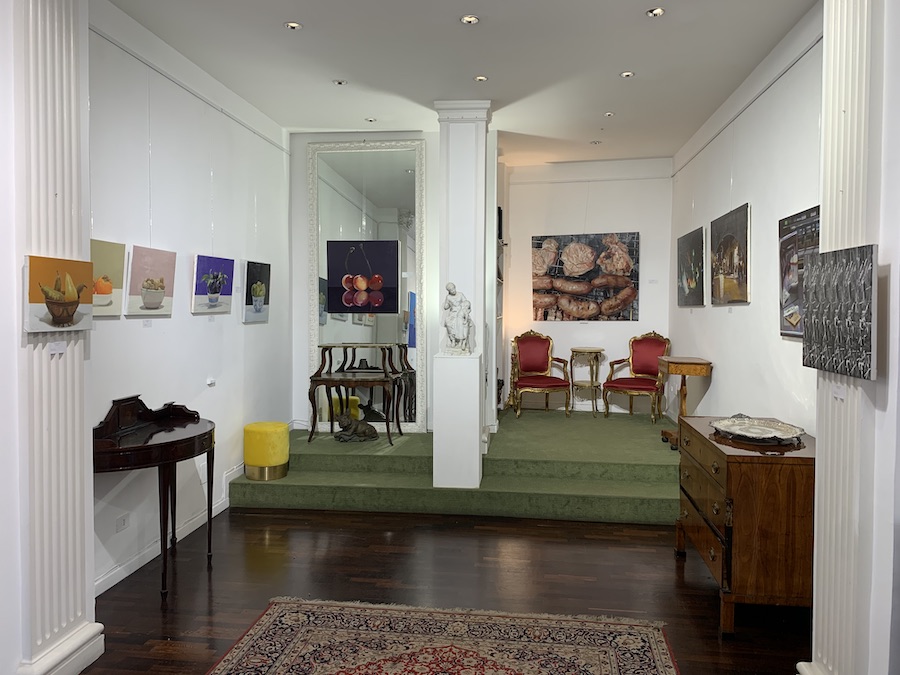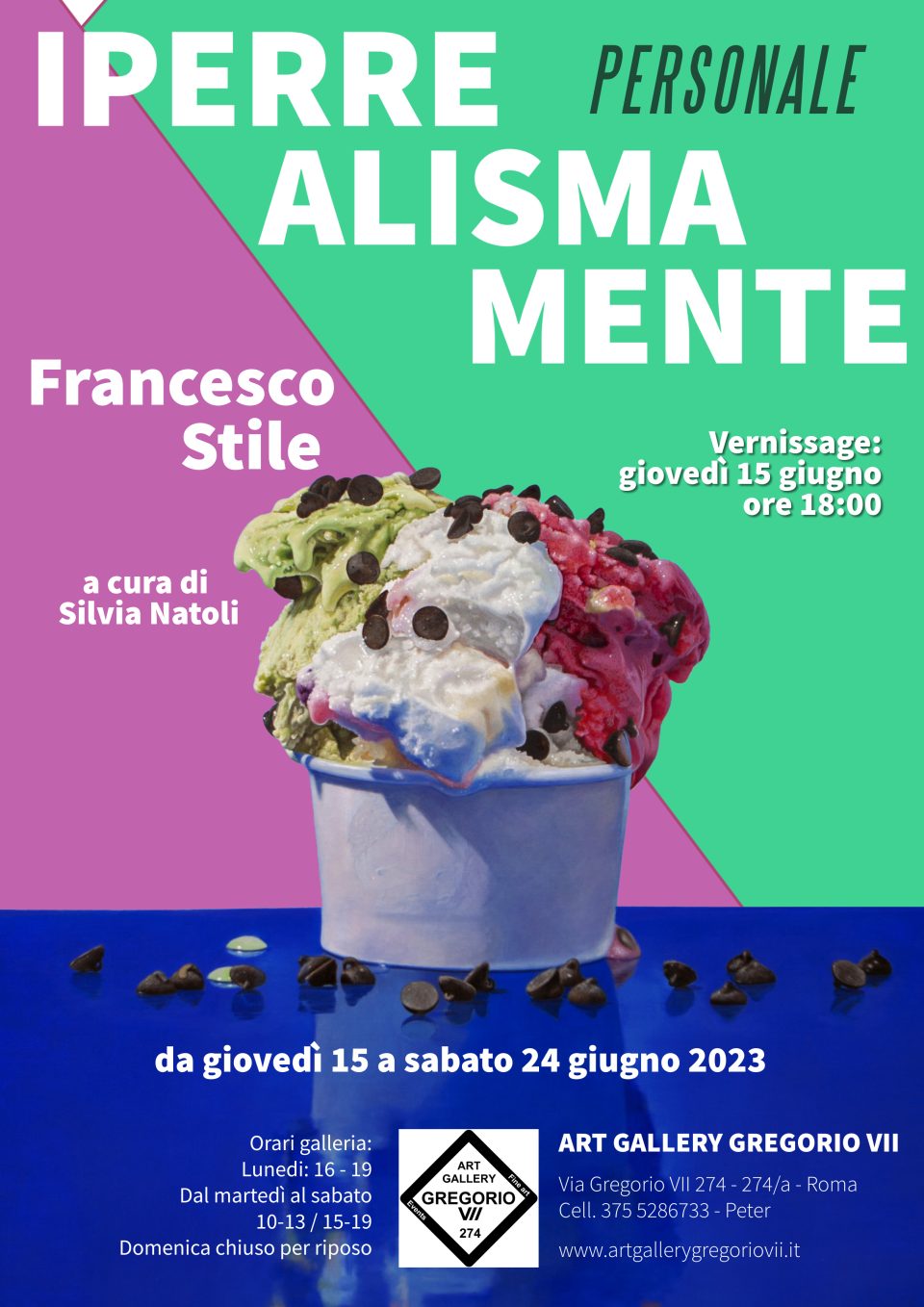



Personale:IPERREALISMAMENTE
Giovedì 15 giugno 2023
Presso Art Gallery Gregorio VII
Via Gregorio VII 284-274/a – Roma

Francesco Stile nasce a Napoli nel 1965. La sua è una provenienza da una stirpe di pittori. La madre, e soprattutto il nonno erano pittori vedutisti napoletani. All’età di tredici anni inizia a frequentare un’antica bottega d’arte, esattamente nell’atelier del ritrattista Carlo Roberto La Volpe, fino alla fine degli anni novanta. Dopo questa esperienza decide di aprire un proprio studio per dedicarsi ai Falsi d’Autore, prediligendo il ‘600 Caravaggesco. Nel gennaio del 1997 nota sulla rivista ART le opere iperrealistiche di un pittore contemporaneo. E’ l’inizio di un nuovo orientamento artistico, caratterizzato da nature morte Iperrealistiche, in olio su tela. Il suo percorso denota un’attività in continua e costante ricerca, che esprime anche attraverso il reale con frammenti di vita quotidiana.




Giovedì 15 giugno 2023
Presso Art Gallery Gregorio VII
Via Gregorio VII 284-274/a – Roma
Di Alessandra Redaelli
Qualche volta la troppa perizia tecnica può essere d’ostacolo a un artista. Qualche volta accade che l’abilità nell’usare il pennello spinga ad accontentarsi di una resa fotografica della realtà. Spaccati esattissimi del vero in cui però un gelo freddo, mortuario, invade l’atmosfera, privando il dipinto di un seppur minimo afflato di vita.
Non è questo il caso di Francesco Stile. Il suo pennello è, sì, preciso come un bisturi nel delineare le crepe che incidono la pelle sottile e friabile della cipolla, così come le irregolarità nella buccia polposa di un’arancia. Ma quel pennello non si ferma mai lì. Come un bisturi, appunto, penetra la realtà regalandoci un terzo occhio capace di guardare dentro alle cose, di udirne il respiro segreto,
siano esse agrumi spaccati di cui si potrebbe giurare di avvertire il profumo persistente, o anche bicchieri, sulle cui curve cristalline la luce gioca come dita su una tastiera, creando una sinfonia di riflessi.
Nello sguardo di Francesco Stile, l’attenzione verso l’oggetto si rivela amore spasmodico per le cose. Quasi una forza superiore che spinge a dipingerle e a ridipingerle per fermarne l’esistenza in un perfetto istante eterno.
E per ogni quadro, per ogni soggetto, Stile trova sempre il linguaggio più adatto. Quello verista, espressionista, che usa per dipingere i funghi sparpagliati sulla tavola, ancora umidi di terra e muschio, intrisi dell’odore selvaggio e pungente di sottobosco. Quello sussurrato, minimale, verrebbe da dire monastico, che dà vita a un cesto di uova composto e ordinato sotto una luce tenue. E poi quello carnale, erotico quasi, con cui dà la consistenza di una serica pelle femminile alla buccia liscia delle prugne mature, o che gli fa porre in mezzo a una cesta caravaggesca una melagrana spaccata, da cui fuoriescono semi lucenti di un rosso sanguigno.
Lo sfondo ogni tanto riporta scorci di ambienti, una ricerca di contatto con la quotidianità. Ma il più delle volte il piano bianco della tavola incontra il grigio neutro dello sfondo – o addirittura un nero profondo e insondabile – su una nitida linea d’orizzonte che nulla ha a che fare con il quotidiano. In quello spazio irreale, allora, abbagliate da una luce potente che ne incide le forme, queste nature morte diventano icone metafisiche, archetipi di una bellezza fatta di perfette imperfezioni. E dalle ceneri dell’iper-reale nasce la poesia della
realtà ultra-reale. By Alessandra Redaelli Sometimes too much technical expertise can be an obstacle for an artist. Sometimes the skill in employing the brush can push the artist to be content simply with a photographical reproduction of reality. This very accurate representation of reality can, however, create a mournful bitter cold that overwhelms the atmosphere, depriving the painting of the smallest breath of life. This is not the case for Francesco Stile. His brush is precise like a scalpel in outlining the chinks that carve the thin and flaky skin of the onion, as well the roughness of a pulpy orange peel. But that brush never stops there. Indeed, like a scalpel, it goes deep into reality giving us a third eye able to look into things and hear their secret breath, whether they are from the split citrus from which it seems we can smell its persistent scent, or even the crystalline curves of glasses, where light plays like fingers on a keyboard, creating a symphony of glare.
From Francesco Stile’s gaze, the attention to the object becomes a troubled love for things. It seems like a higher power that pushes him into painting and repainting them
to stop their existence in a perfect eternal instant.
And for every painting, for every subject, Stile always finds the most suitable style, like the Veristic, or the Expressionistic, which he uses to paint the mushrooms spread on the table, still wet by ground and moss, soaked by the wild and pungent smell of undergrowth. Or the whispered, minimal, one could say almost monastic style, that gives life to an egg basket put together and ordered under a faint light. And even the carnal, almost erotic, style where the smooth peel of the ripe plums seems like silky
feminine skin, or when, among a “caravaggesco” basket, we can see shining blood red seeds coming out from a pomegranate split.
Sometimes the background shows glimpses of environments, as a way to research contact with everyday life. But most of the time, the white countertop of the table
meets the neutral gray background – or even a deep and unfathomable black – on a clean skyline that has nothing to do with everyday life. So, in that unreal space, dazzled by a strong light that engraves their shapes, these still lives become metaphysical icons, archetypes of a beauty made of perfect imperfections. And so, the poetry of ultra-real reality rises from the ashes of hyper-realism.